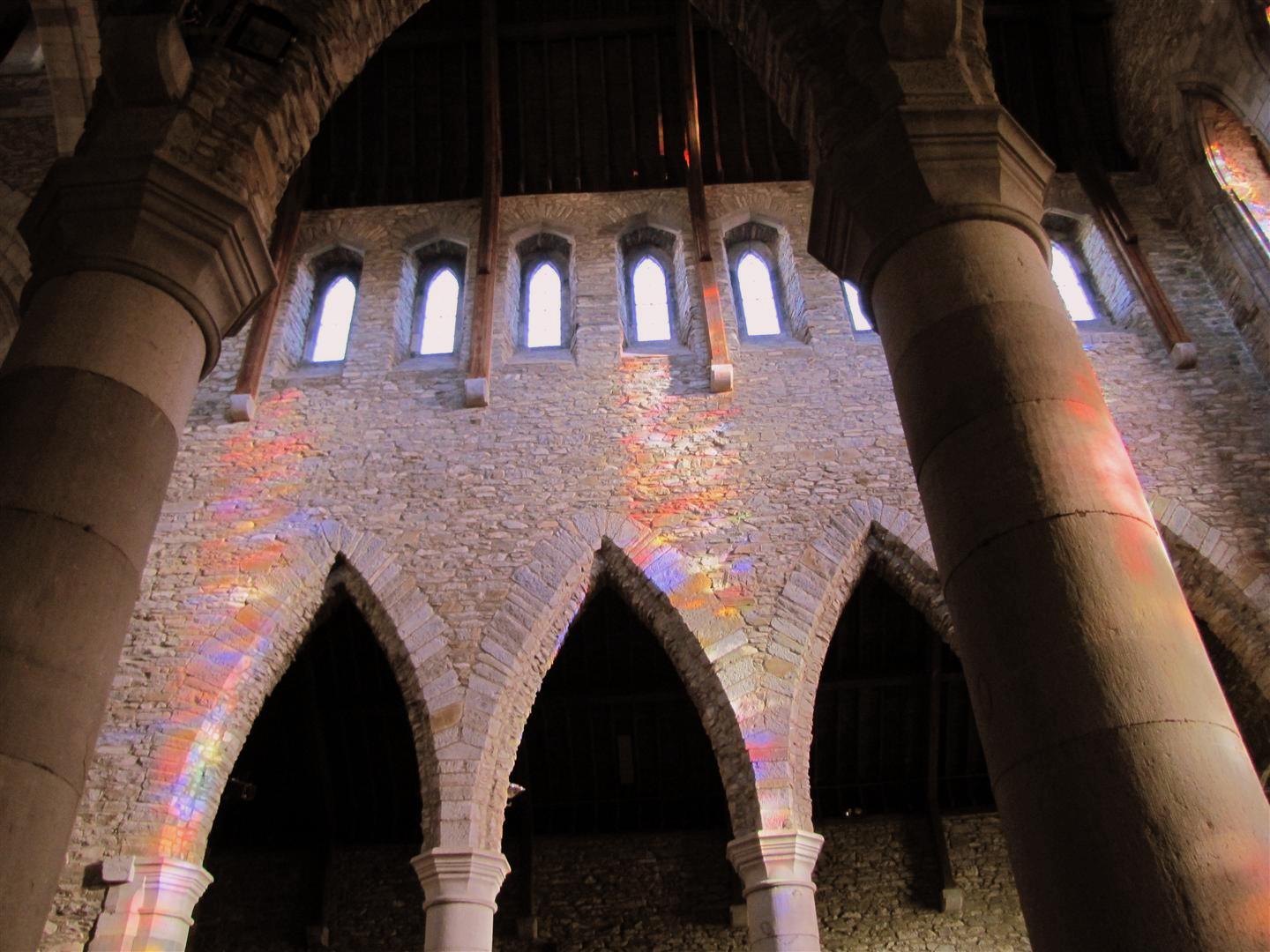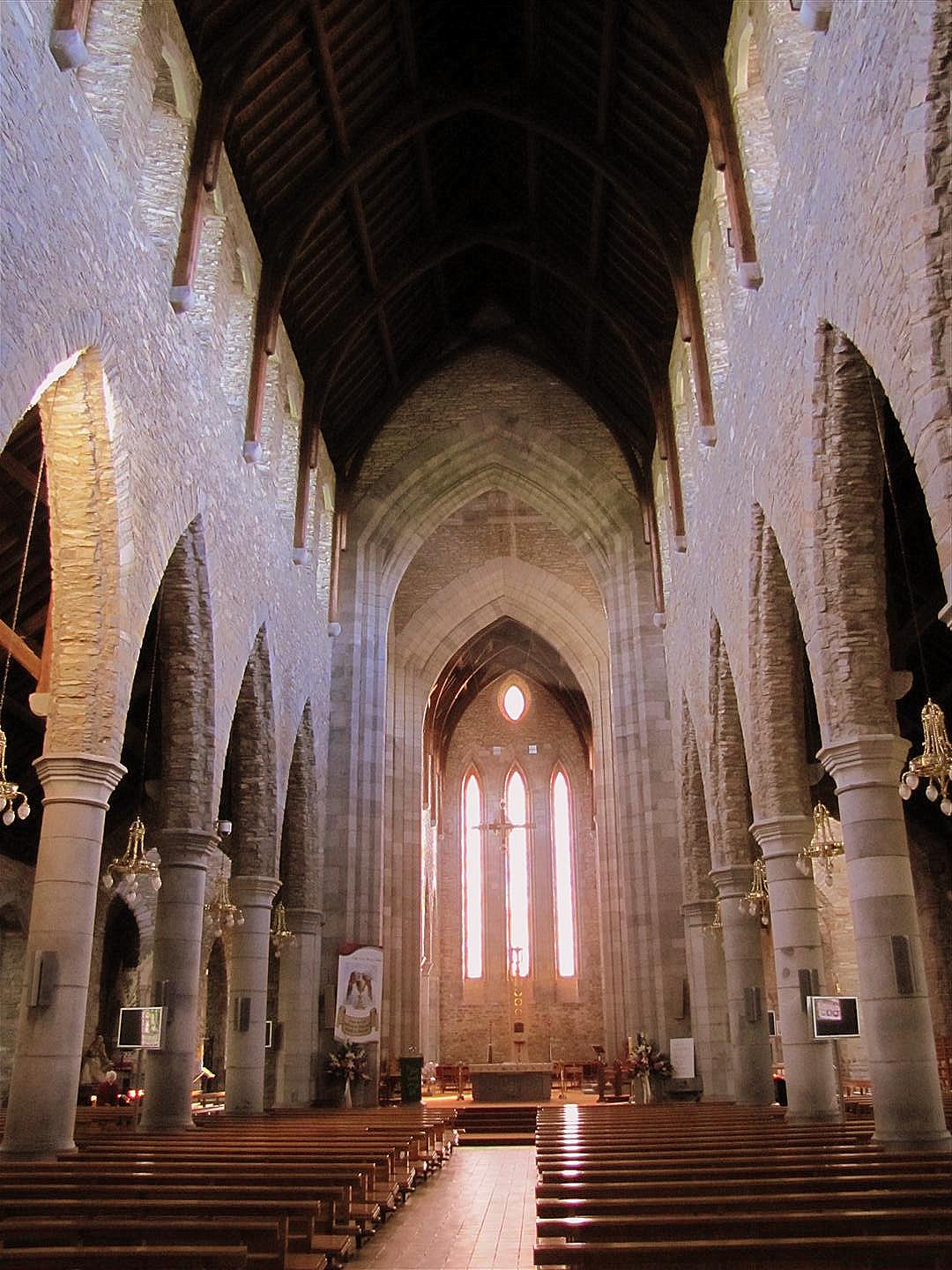"The diocese of Kerry (formerly Ardfert and Aghadoe) was ruled by
vicars apostolic from the mid-16th century until the early 18th
century, with the exception of a brief few years in the 1640s. The 18th
century Bishops of Kerry resided at Dingle, Kilcummin, Tuogh, Listowel
and Tralee, from 1720 until 1775. In the latter years Bishop Francis
Moylan (1775-87) established the see at Killarney.
Before
the construction of
Killarney cathedral there was a small chapel in Chapel Lane, of which
the font survives in the baptistery of the present cathedral. The idea
of building a cathedral was begun by Fr. Joseph O'Sullivan, curate of
Dingle, who roused the enthusiasm of Bishop Cornelius Egan (1824-1856)
and the 2nd Earl of Kenmare (1788-1853), a local Catholic landowner.
A subscription list was opened in 1828, and a building committee was
formed in 1836; Fr. O’Sullivan was transferred to Killarney in that
year and placed in charge of the committee. By 1840 they had collected
only £900, but, undaunted, they commissioned Augustus Welby Pugin
to design a new cathedral. His design drew some inspiration from the
ancient ruined cathedral at Ardfert, most notably in the slender triple
lancets in the east wall, which are repeated in the west wall and in
each transept. Killarney was Pugin's personal homage to his favourite
cathedral, Salisbury Cathedral.
A site was acquired from the Presentation Brothers, and the foundation
stone was laid in the summer of 1842. Funds were still short, and
public appeals were made in Ireland and the US. Work continued under
the supervision of Richard Pierce of Wexford (Pugin being unable to
undertake personal supervision) until May 1848 when the full effects of
the failure of the potato crops in 1846 and 1847 were felt and the
Great Famine spread throughout Ireland. No work was done for five
years, and during that time the two men who had done so much to produce
the cathedral, both died. Fr. O’Sullivan died in Oct. 1851, and Pugin
in September 1852.
Construction was resumed at the beginning of 1853, and J. J. McCarthy
succeeded Pugin as architect. Two years later, the total cost having
risen to £20,000, the cathedral was free of debt, substantially
complete, and ready for divine worship.
On 22 August 1855 it was consecrated and dedicated to the Assumption of
the Blessed Virgin Mary in the presence of McCarthy and Edward Pugin,
the architect’s eldest son, who said later that of all the sixty-odd
churches designed by his father, Killarney had been his father’s
favourite.
Bishop Egan, now elderly and frail, had been taken to the cathedral in
a chair on the previous day and was moved to tears when he surveyed the
building that he had helped to begin twenty-seven years earlier.
It is built in the first period of the pointed style known as Lancet
arched Gothic, and is noted for its long, slender lancet windows and
its acutely pointed arches. So beautifully proportioned are all its
parts, and so strikingly majestic, that it has been mentioned as the
finest specimen of revised Gothic in these islands. Interiorly the
Church has a very solemn and devotional appearance, the lofty windows
admitting a soft, spectral light. The pointed arches, resting on
circular shafts of plain, chiselled limestone, with simple Doric
capitals, add stateliness to the structure, while those of the tower,
rising almost to the roof, are awe- inspiring in their height and
massiveness.
Although
the cathedral was now
usable for worship, it was still unfinished. Pugin’s design for a great
central tower was left for future generations to build. An organ was
installed in 1869 and minor additions were made by Bishop Egan’s
successors, but the final effort began in 1907. Bishop John Mangan sent
priests to the US and to Australia to raise funds to complete the work
begun in 1842. The firm of George Ashlin and Thomas Coleman, who had
designed Cobh Cathedral, were appointed to complete the work of Pugin
and McCarthy. The nave and aisles were extended westwards by 8.2 m to
create two new bays; a new sacristy and mortuary were built; pinnacles
were added to the flanking turrets at the west end, and a pinnacle at
the east end to join one already there; the crossing piers were
strengthened, and a great tower and spire, 86.8 m high, were
constructed above at a cost of £36,500. The work was completed
and the cathedral finished in 1912.

Killarney Cathedral is set in spacious grounds on a level site
reminiscent of the plain of Salisbury Cathedral. Pugin used grey, red
and brown sandstone with dressings of limestone. This creamy exterior
contrasts with the grey of the slate roof, spire and pinnacles and
gives the cathedral a softer appearance than it might otherwise have
had. The plan is cruciform, with an aisled nave of six bays,
clerestory, transepts and an aisled chancel of four bays. The former
baptistery, off the north nave aisle, has a double font, mosaic work
and a coffered vault with stencil design. The former Mortuary Chapel,
off the south nave aisle, lacks the original floor. The gallery at the
west end of the nave contains an organ by Telford & Son, erected in
1869. In the early 1970’s it was rebuilt and divided, to reveal the
lower part of the west window.

Bishop
Eamonn Casey (1969-76) launched a fund-raising campaign in
December 1970 for the restoration and re-ordering of the Cathedral. The
work lasted from April 1972 until July 1973 and the total cost was over
a million and a half pounds. The designer was Ray Carroll of
Glencullen, Co. Dublin, and the supervising architect was Daniel J.
Kennedy of Tralee. Carroll adopted a very radical and much-criticised
approach to the re-ordering of the Cathedral, and apart from a few
small areas, nothing of the former interior remains to be seen. The
greatest single change was the removal of all the internal Victorian
plasterwork. The original reredos, altar and screens were removed, the
floor of the crossing was raised to the level of the former sanctuary,
and a new sanctuary was created at the crossing. A new altar, pulpit,
throne and chairs, all made of Tasmanian oak, were installed. A new
font consisting of a limestone bowl was fitted into the angle between
the south-west pier of the crossing and the first pier of the south
nave arcade. In the north transept the former St. Patrick’s Altar was
removed.
The north chancel aisle was formerly the Chapel of St. Joseph. It was
emptied during the re-ordering, and the only indication of its former
use is the rather sad plaque on the easternmost column, recording the
fact that the chapel was ‘decorated and fitted
for divine service’ by John Morrogh Bernard and Francis Maria Raymond,
who had bequeathed the 5-acre (20,000 m2) site on which the cathedral
stands to the Presentation Brothers. The proposal to build the
cathedral technically invalidated the bequest. Bernard stood to inherit
the land in the case of such invalidation, but in a rare act of
generosity, he drew up new leases, allowing the site to be used for the
cathedral. As one author has noted, ‘It is one of the sadder results of
the renovation that this plaque is all that remains to commemorate him
and his family’." -
Wikipedia